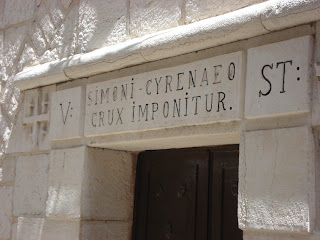Our afternoon of sightseeing revolved around the Stations of the Cross and the Via Dolorosa. We wouldn't see all the stations, and the actual location of each one is highly debatable.
The Stations themselves are usually a series of 14 pictures or sculptures depicting the following scenes. We would see several on our visit. I copied the list below from Wikipedia.
- Jesus is condemned to death
- Jesus is given his cross
- Jesus falls the first time
- Jesus meets His Mother
- Simon of Cyrene carries the cross
- Veronica wipes the face of Jesus
- Jesus falls the second time
- Jesus meets the daughters of Jerusalem
- Jesus falls the third time
- Jesus is stripped of His garments
- Crucifixion: Jesus is nailed to the cross
- Jesus dies on the cross
- Jesus' body is removed from the cross (Deposition or Lamentation)
- Jesus is laid in the tomb and covered in incense.
The first station we would visit was number 5, where Simon of Cyrene carries the cross for Jesus.
Adjacent to the 5th Station is where Jesus paused and rested his hand against the wall. People since then have done the same thing, so of course I did too.
The next station, number 6, is where Veronica offered her veil to Jesus so that he might wipe his face. When he handed it back to her, his image appeared on the veil. Veronica is Latin means "Bearer of Victory", and while there is no mention of her act in the Gospels, both the Greek Orthodox and the Catholics have embraced the legend.
When we get to Station Seven, where Jesus falls for a second time, there are two interpretations. According to Catholic and Orthodox tradition, Jesus went left, where today stands the Church of the Holy Sepulchre. Protestant tradition holds that he went right towards what is today the Garden Tomb (more on that later).
The Via Dolorosa ends at what is now the Church of the Holy Sepulchre. Tradition (depending on your denomination) holds that the church is built on the site of Golgotha, the Hill of Calvary, where Jesus was crucified. Records indicate that Christians have been making pilgrimages here since at least the 4th century, if not earlier. Custody of the site is shared between different Christian faiths in rather complicated agreements that go back for centuries. The site was originally a temple dedicated to the Greek goddess Aphrodite. The Emperor Constantine and his mother Queen Helena, had the site leveled and rebuilt as a church. The church was destroyed in the 11th century by Persian conquerors and was a major catalyst for the Crusades, when it was subsequently rebuilt.
The stairways take you up the 11th/12th Stations of the Cross, at Calvary, where the actual crucifixion took place. The site now houses The Chapel of the Nailing of the Cross and the Altar of the Crucifixion.
The Stone of Anointing, located at the entrance of the church is where the body was laid after being taken down from the cross and prepared for burial by Joesph of Arimathea. This would be the 13th Station of the Cross.
The Sepulchre or Tomb, where the body was placed for burial is the final station, number 14.
Upon entering the church, you are immediately overcome by your senses. There is the smell of incense burning, the loud music from the organs, the chanting of the priests. It's hard not to get emotional. As I was walking into the church and saw the Anointing Stone, there was a woman, obviously Russian or Eastern European, who was sitting in front of the stone with her hands on it, just sobbing.
There is a wonderful tiled mosaic on the wall behind the Stone of Anointing. It was not possible to capture it all in one shot, so I attempted to shoot a video of it using my camera. Kirsten and I both noticed the crying angels.

















No comments:
Post a Comment